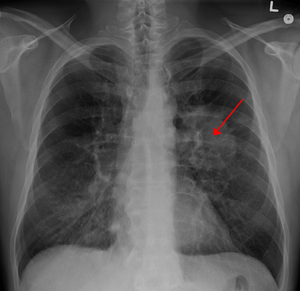

Symptoms
There are many symptoms of lung cancer like continuous coughing, shortness of breath and wheezing. The patient may experience coughing up blood, and it is primarily observed in smokers. There also other symptoms of lung cancer like fatigue, fever, weight loss. In some cases, the finger and the fingernails start deformation, which is a condition known as clubbing.
The invasion and compression of the structure near the tumour can also cause other symptoms, like hoarseness, chest pain and swelling of the neck and the face. If there is a blockage which is preventing the flow of the blood back to the heart from the lungs, it results in a condition called superior vena cava obstruction.
Diagnosis
Lung cancer can be diagnosed with the help of many tests. The first step towards the diagnosing process adopted by the doctor is to take X-ray and use the imaging technique called CT. CT scan is done as it is useful in providing more information about the location of the disease, extent and type.
In many cases, the specialist will need to do a biopsy to extract and evaluate the tumour sample. The most common way to do so is bronchoscopy. During this process, the specialist inserts a narrow tube in the lungs and then takes a small tissue sample. An image-guided needle biopsy can also be used for the biopsy of lung cancer tumour cells.
If the cancer is at the top of the lung, it means that it has invaded the network of nerves in your chest and neck. The network which is invaded in this case is known as brachial plexus or the vascular system. Thus, there could be a need for performing medical imaging processes like MRI to locate the tumour.
There also other imaging techniques which can be used to detect the cancerous cell. The most common one is called positron emission tomography (PET), in which a small amount of tracer is injected, which travels in the blood, tissue and organs. The tracer injection and routing allows the specialist to see the target areas more clearly.
Treatment
The specific characteristics of cancer such as tumour cell type, size and location define the treatment options. Such characteristics are evaluated to see whether the disease is metastasized or not, and how well the patient’s heart and respiratory systems are working.
The most curative treatment is surgery. If the surgery cannot be performed, and the disease is limited to lung, there is also another technique which is image-guided ablation. This can play a significant role in the treatment of lung cancer. In this process, the radiologist inserts a needle in the tumour with the aid of medical image guidance. Than radiofrequency energy is delivered to the tumour. As a result, the tumour is destroyed by using microwave heat or gas that would freeze the tissue.
Chemotherapy and radiotherapy can also be used for the treatment of patients to increase the quality and longevity of life.
Dr Nikolas Charalambous is named among the most prominent interventional radiologist. Get a free consultation for a minimally invasive treatment of brain, neck, and spine.